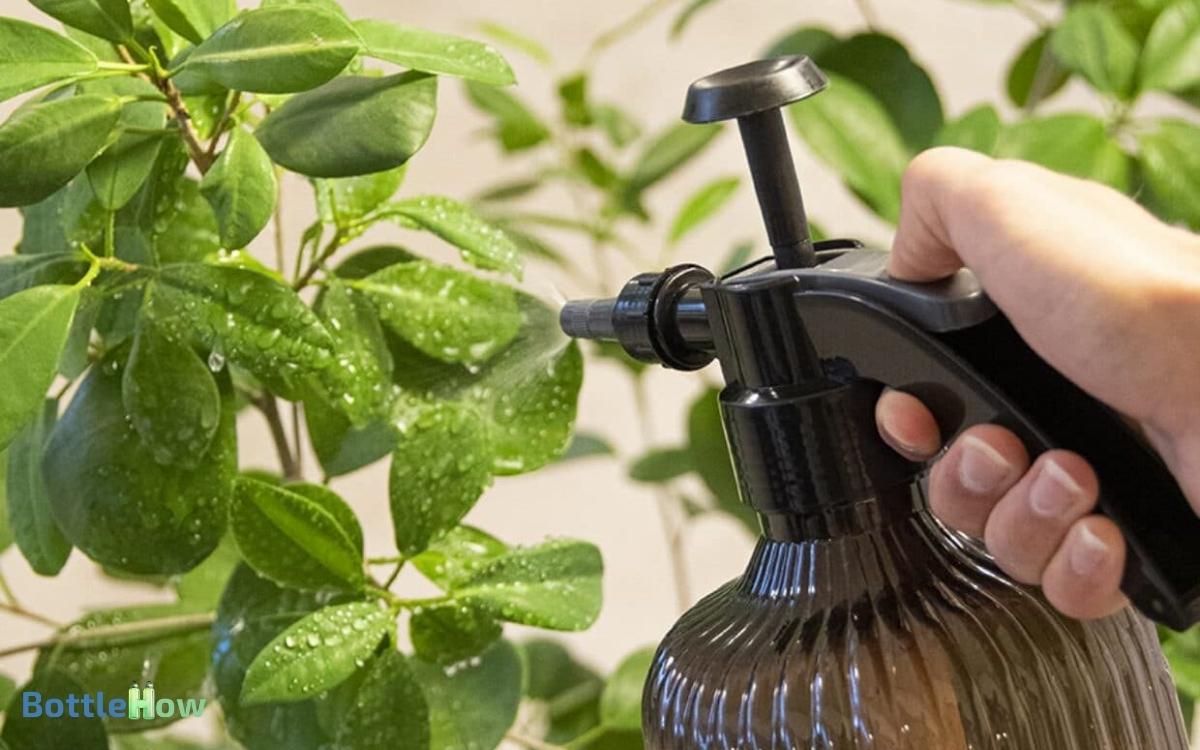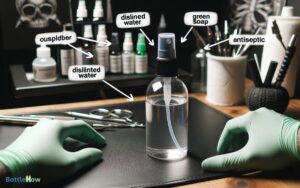Spray Bottle to Increase Humidity: A Complete Guide!
To increase indoor humidity effectively, you’ll want to choose a spray bottle that suits your needs. Opt for one made from durable materials like plastic or glass and make sure it features an adjustable nozzle.
This allows for a fine mist that evenly distributes water without over-saturating any area. Aim for a size between 300-500 ml for ease of use.
Regularly mist your plants and environment in the early morning or late evening to maintain ideal humidity levels, which should range between 40%-60%.
With the right approach, your home will soon become a more comfortable and healthier space. Discover how these adjustments can further enhance your indoor environment.

Key Takeaways
Understanding Indoor Humidity
Why should you care about indoor humidity? Knowing its level in your environment is vital for maintaining both health and comfort.
Indoor humidity refers to the amount of water vapor present in the air inside a building. It’s measured as a percentage, termed relative humidity (RH).
Ideally, you’d want to keep RH levels between 30% and 50%. Below or above this range can lead to discomfort and various health issues.
You can measure humidity using a device called a hygrometer; this tool will help you monitor the air quality effectively.
Adjusting indoor humidity isn’t just about comfort—it’s about creating a healthier space for everyone, especially those you serve, ensuring their environment is neither too dry nor excessively moist.
Benefits of Higher Humidity
Increasing humidity levels can help alleviate dry skin and respiratory symptoms, making your living or working environment more comfortable.
When you consciously raise the humidity, you’re fundamentally adding moisture to the air, which can be particularly beneficial during dry seasons or in naturally arid climates.
Here are some specific advantages:
- Enhanced Breathing Comfort: Moist air can reduce the occurrence of nosebleeds and sinus congestion.
- Preservation of Wooden Furniture and Floors: Dry air can cause wood to split and crack. By maintaining adequate humidity, you’re helping to preserve the integrity and appearance of wood furnishings.
- Improved Plant Health: Many houseplants thrive in a more humid environment, so by increasing indoor humidity, you’re also supporting your indoor garden to flourish.
Choosing the Right Spray Bottle
To effectively raise your home’s humidity, selecting the right spray bottle is a key step. You’ll want a bottle that’s durable, easy to use, and suitable for frequent use.
Here’s a simple guide to help you choose:
| Feature | Why It Matters | Recommended Type |
|---|---|---|
| Material | Durability & Safety | Plastic, Glass |
| Nozzle Type | Spray Pattern Control | Adjustable |
| Capacity | Convenience in Handling | 300-500 ml |
| Ergonomics | Ease of Use | Comfort Grip |
Opt for a bottle that provides an adjustable nozzle to control the mist output, ensuring a gentle, even distribution of water.
A comfortable grip will make the task easier, letting you serve your household needs without strain. Choose wisely to make your efforts as effective and satisfying as possible.
Frequency of Spraying
To keep your plants thriving, you’ll need to think about how often you’re spraying them to maintain ideal humidity.
Understanding the best times for spraying can greatly impact plant health, ensuring they receive just enough moisture without over-saturating.
Regularly adjusting your spraying schedule helps in sustaining necessary humidity levels around your plants.
Optimal Spraying Times
You’ll achieve the best humidity levels by spraying water around your plants two to three times daily, depending on the dryness of your environment.
To optimize your spraying routine, consider these practical tips:
- Morning Ritual: Start your day by misting your plants early in the morning. This mimics the natural morning dew and prepares your plants for the day ahead.
- Afternoon Check: If your indoor air tends to dry out as the day progresses, a quick spray in the early afternoon can help maintain moisture levels.
- Evening Settle: Give your plants a gentle misting in the evening as temperatures start to drop, which helps them retain moisture overnight without becoming overly damp.
Impact on Plant Health
How does the frequency of spraying impact the health of your plants? It’s important to understand that each plant species has unique moisture needs.
Over-spraying can lead to fungal infections and root rot, particularly in plants that prefer dry conditions.
Conversely, under-spraying might stress plants that thrive in high humidity, causing them to dry out and weaken.
To optimize plant health, you’ll need to observe your plants closely. Look for signs of distress, such as wilting, yellowing, or dropping leaves. These symptoms often indicate whether you should adjust your spraying routine.
Generally, start with misting once a day and adjust based on how your plants respond. Remember, your goal is to foster a thriving environment, not just to water.
Humidity Levels Maintenance
Adjusting the frequency of your spray bottle’s use is critical for maintaining ideal humidity levels around your plants.
To effectively manage this, consider the following points:
- Assess your plant’s needs: Different plants require varying humidity levels. Research your specific plant types to understand their unique requirements.
- Monitor environmental changes: Seasonal changes and indoor heating or cooling can affect humidity levels. Adjust your spraying accordingly to compensate for these changes.
- Use a hygrometer: This tool measures the humidity in the air. Regularly check it to guarantee the humidity levels are within the ideal range for your plants.
Best Times to Spray
Spraying your plants early in the morning or late in the evening maximizes moisture absorption and minimizes evaporation.
These are pivotal moments when the sun’s rays are less intense, allowing the water to seep deeply into the leaves without quickly evaporating.
You’ll find that this practice not only enhances the health of your plants but also conserves water—an act of care for our environment.
To effectively serve your plants’ needs, establish a routine. Consistency in spraying at these ideal times can lead to more robust growth. Remember, the goal is to mimic the natural dew they’d encounter in their native habitats.
This attention to detail will ensure they thrive, reflecting your dedication to nurturing and preserving the beauty of life around you.
Target Areas for Spraying
When considering where to spray to effectively raise indoor humidity, you’ll want to focus on ideal indoor locations such as near your houseplants or in dry areas of your home.
Understanding your plants’ moisture needs helps in targeting your spraying efforts more precisely, ensuring they receive just the right amount of moisture daily.
Establish a daily spraying schedule to maintain consistent humidity levels, which will benefit both your plants and your overall indoor air quality.
Ideal Indoor Locations
To effectively increase indoor humidity, target areas such as living rooms, bedrooms, and greenhouses where air tends to be dryer.
These spaces often house delicate furniture and plants that thrive in moist environments, making them ideal for your attention.
Here’s how you can maximize the benefits:
- Living Rooms: Frequently used, this area benefits greatly from increased humidity, especially near fabric sofas and wooden furniture which can dry out.
- Bedrooms: Spraying in corners and around the bed promotes better sleep environments by maintaining ideal air moisture levels, essential for respiratory health.
- Greenhouses: Focus on the air around your plants without wetting the leaves directly to create a nurturing atmosphere for growth.
Plant Moisture Needs
Understanding your plants’ moisture needs is essential for determining the most effective areas to target with your spray bottle.
Begin by evaluating the foliage; many tropical plants benefit from misting on their leaves to mimic their humid natural habitat.
Focus on the underside of leaves where stomata, the pores that facilitate gas exchange, are more concentrated.
This can enhance their ability to breathe and absorb moisture, promoting overall health and vibrancy.
Avoid wetting the flowers directly as this can lead to fungal diseases. Instead, aim to gently mist around them, ensuring the surrounding air has humidity without causing harm.
Daily Spraying Schedule
Setting a daily spraying schedule will guarantee that your plants receive consistent, targeted moisture where they need it most.
To guarantee effectiveness, focus on these key areas:
- Leaves and Stems: Give a gentle mist to the leaves and stems early in the morning. This mimics morning dew and helps them perform photosynthesis efficiently.
- Base and Soil: Spray around the base of the plant to maintain soil moisture without overwatering. This encourages roots to seek water and grow stronger.
- Surrounding Air: Lightly mist the air around your plants to boost the humidity, especially if you’re using indoor heating or air conditioning, which can dry out the air.
Effects on Houseplants
Using a spray bottle to mist your houseplants can greatly boost their humidity levels, often essential for their health and growth.
This method helps maintain the moisture they’d naturally get in their native habitats, particularly for tropical plants.
Misting also cleans the leaves, which enhances photosynthesis by allowing more light to reach the plant cells.
Here’s a handy table summarizing the benefits:
| Benefit | Description |
|---|---|
| Enhances Growth | Mimics natural, humid conditions. |
| Cleans Leaf Surface | Removes dust for better photosynthesis. |
| Prevents Pests | Deters spider mites and other pests. |
| Reduces Stress | Helps plants recover from dry air. |
Monitoring Humidity Levels
To guarantee your houseplants thrive, you’ll need to maintain the ideal humidity range, typically between 40% and 60%.
You can monitor this effectively by using a hygrometer, a device that measures the moisture level in the air.
Place it in the room where you use your spray bottle to track humidity changes and adjust your spraying routine accordingly. This will help you maintain the ideal moisture levels for your plants or personal care routine. If you’re looking for alternatives, researching how to wet hair without spray can provide useful tips, such as using damp hands or a wet cloth. Monitoring humidity closely ensures that you’re not over- or under-misting, leading to healthier results.
Ideal Humidity Range
Monitoring humidity levels effectively guarantees you maintain the ideal range, typically between 40% and 60%, to promote a healthy environment.
Staying within this range not only supports your well-being but also helps in preserving the integrity of your home and belongings.
Here’s how you can achieve this:
- Regular Adjustments: Adjust your spray bottle usage based on current readings. If it’s too dry, increase spraying frequency.
- Room Size Consideration: Remember, larger rooms may require more frequent spraying to achieve the desired humidity.
- Seasonal Changes: Be mindful of seasonal humidity variations. Increase spraying during dry months like winter and reduce it when it’s naturally humid.
Using Hygrometers Effectively
How can you guarantee your hygrometer readings are precise for effective humidity control?
First, you’ll need to calibrate your device. Most hygrometers can be calibrated using the salt test method, which involves placing salt and water in a sealed container with the hygrometer and checking the reading after 24 hours. It should show 75% humidity; if it doesn’t, adjust accordingly.
Place your hygrometer in the area you’re most concerned about, away from direct heat sources or drafts, as these can skew the readings.
Check the humidity levels regularly, especially if the weather changes or you’ve adjusted the room’s humidity.
Additional Humidity Methods
Beyond using a spray bottle, you can also boost humidity by placing water-filled trays near heat sources in your home. This method leverages the natural heat to evaporate water, adding moisture to the air efficiently.
To further enhance indoor humidity, consider these practical steps:
- Group Plants Together: Placing several plants in close proximity creates a microenvironment with higher humidity due to collective transpiration.
- Use a Room Humidifier: Deploying a humidifier can provide continuous humidity control, especially in larger spaces or particularly dry seasons.
- Incorporate Indoor Water Features: Adding items like tabletop fountains can increase air moisture through evaporation while also enhancing your home’s aesthetic.
These methods complement your existing efforts, ensuring the comfort and health of everyone in your space.
Mistakes to Avoid
When increasing humidity in your home, it’s important to avoid over-misting, as this can lead to mold growth and damage to furnishings.
You should also make sure you’re not just focusing on one area. Uniformly distribute the mist throughout different rooms to prevent localized damp spots.
Don’t mist directly onto surfaces like wood or leather, which can absorb moisture quickly and deteriorate. Instead, aim the spray upward allowing the mist to disperse evenly into the air.
Keep in mind that not all plants require the same amount of humidity; over-misting plants that prefer drier climates can harm them.
It’s essential to tailor your approach to the needs of your environment and the wellbeing of your household and greenery.
Maintaining Your Spray Bottle
To guarantee your spray bottle functions effectively for increasing humidity, regularly clean and inspect it for any signs of wear or blockage.
Here’s how you can maintain it:
- Regular Cleaning: Every week, empty the bottle and rinse it with warm water. Use a mild soap if necessary to remove any residue or buildup. Rinse thoroughly to prevent any soap particles from clogging the nozzle.
- Check the Nozzle: After cleaning, spray a few times to verify the nozzle isn’t clogged. If there’s a blockage, soak the nozzle in warm vinegar for a few hours, then rinse with water.
- Inspect for Damage: Look for cracks, leaks, or any damage that might impact the spray function. Replace parts as needed to keep the bottle in good working condition.
Conclusion
As the oasis thrives with each pulse of the mister, so will your home with every spritz of moisture. Picture each gentle spray as a breath of life for your indoor world, nurturing your sanctuary’s vitality.
Remember to maintain your spray bottle—your trusty raincloud in hand. Regularly check humidity levels to confirm your personal Eden flourishes.
Embrace this simple ritual; it’s a small step towards transforming your space into a thriving haven.






